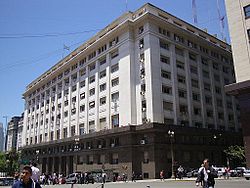Minister of Economy (Argentina)
| Ministerio de Hacienda y Finanzas Públicas | |
 |
|
 Palacio de Hacienda, headquarters of the Ministry. |
|
| Ministry overview | |
|---|---|
| Jurisdiction | Argentina |
| Headquarters | Buenos Aires |
| Employees | 4,000 (2009) |
| Annual budget | US$1.7 billion (2009) |
| Ministers responsible |
|
| Parent department | Government of Argentina |
| Website | http://www.economia.gob.ar |
Ministry of Economy and Public Finances was the historical name of the current Ministry of the Treasury and the Ministry of Finance. It was concerned with finance and monetary matters, and its position within the Government of Argentina was analogous to the finance ministers of some countries (e.g. the United States Treasury Secretary). The Ministers currently in charge of its duties are members of the President's Cabinet, the posts are held by Nicolás Dujovne as the Minister of the Treasury and Luis Caputo as the Minister of Finance.
The Argentine Ministry of the Economy has, since the building's 1939 inaugural, been based in a 14-story Rationalist office building designed by local architect Carlos Pibernat. The Economy Ministry building was built on a 0.57 ha (1.4 ac) Montserrat neighborhood lot facing the Casa Rosada presidential office building to the north, and the Defense Ministry (Libertador Building) to the east – a government building also designed by Pibernat.
The building's lobby was decorated with murals painted by the architect's brother, Antonio Pibernat, a post-impressionist painter influenced by the naturalist Barbizon School.
The post has existed on a formal basis since the 1826 inaugural of Bernardino Rivadavia, who named lawmaker Salvador María del Carril as the nation's first official Ministro de Hacienda. The office became among the most powerful in Argentine Government during the generation after 1880, when English Argentine investment, foreign trade, and immigration spurred development. Customs collections (source of over half of public revenues at the time) and the Central Bank were among the responsibilities placed under the Economy Ministry's aegis, and successive ministers' policies were often enacted through presidential decrees.
...
Wikipedia
